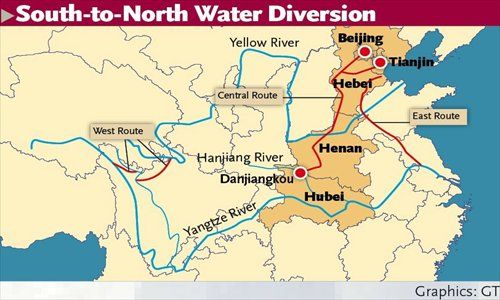Biggest Water Transfer Project Ever Benefits 100m in China
Published on by Water Network Research, Official research team of The Water Network in Government
Two years after China opened an $80 billion mega tunnel to transfer water from the country's south to its parched north, it has quenched the thirst of 100 million people.

This is roughly the combined population of Germany plus the Netherlands. With this project, China mitigated an alarming water crisis and reaping rich economic dividends in 18 of China’s industrial, agricultural-powerhouse cities and capital Beijing.
The 4,350-kilometer network of canals and tunnels— about the distance between the two coasts of America, conquered impossible wastewater challenges to pipe clean water along the route.
In the east line alone, 426 costly clean-up schemes were carried out to reduce 85 percent of pollutants from entering the flow: seepage pits and tainted river basins were filtered; man-made wetlands laid; contaminated streams cut off; paper mills, chemical plants and more heavy polluters shut down or revamped; 510 planned projects involving $3 billion in investments bypassed for purposes of pollution control.
On June 9, the South-to-North Water Diversion Project Construction Committee shared prominent figures relating to the massive project’s completion.
Since becoming operational in late 2014, the central line has ferried 8 billion cubic meters of water from southern China’s Yangtze River to Beijing, China’s political center with a population of 21.5 million but an average per capita quantity of water at 150 cu m, 1/14 of national average and 1/50 of world average, now its 73 percent of tap water in urban areas comes from the transit; Hebei, a mammoth water consumer as it produces China’s 1/5 raw steel and world’s 1/10; Henan, one of China’s top two grain producers since 2000, with a whopping 2016 output of 59 million tons; Tianjin, the only free-trade zone in northern China and a hi-tech manufacturing cluster.
Shandong, China’s 2nd largest wheat producer and 3rd most water-stressed province, with 1/6 the national average per capita quantity of water, has received 1.99 billion cubic meters of water from the east line, benefiting 40 million people.
Tough environmental measures ensure water quality, as all the diverted water safely qualifies as Grade III - the minimum standard for drinking water, also usable in aquatic breeding areas.
Water in the central line meets Grade II standards, with some samples approaching Grade I, the cleanest level and considered safe for nature reserves. In Beijing, the hardness of water has dropped from 380 to 120 milligrams per liter since the imported water began to flow in, Beijing Waterworks Group determined.
The effects on nature have been amazing, too. The water transit has prevented the exploitation of over 800 million cubic meters of underground water in the already-depleted north; in addition, as surface water filters into the ground, underground water levels in over-exploited areas of Beijing, Henan and Shandong have increased.
In 2016, for the first time in decades, Beijing's underground water level rebounded by 0.52 meters. In the same year, Shandong diverted 145 million cubic meters from the scheme to recharge its four lakes, effectively shoring up a vulnerable ecosystem.
Read more: People's Daily
Media
Taxonomy
- Resource Management
- Water Resource Management
- River Studies
- River Engineering
- Water Supply
- Infrastructure
- Integrated Infrastructure
- Water Resource Management
- Infrastructure Management
- Water